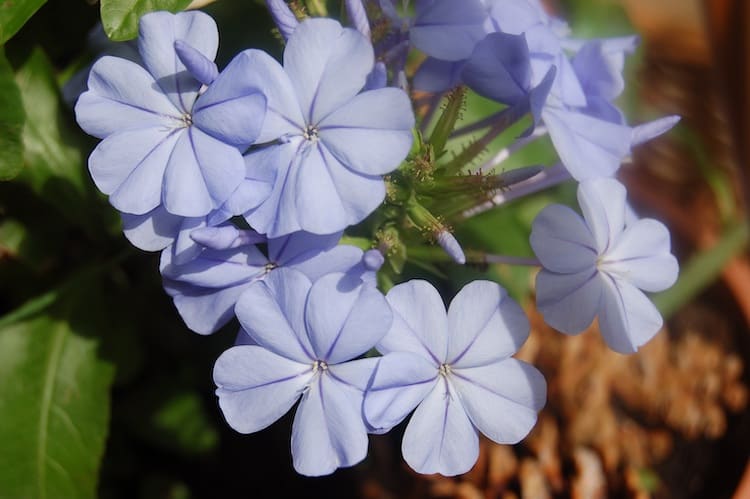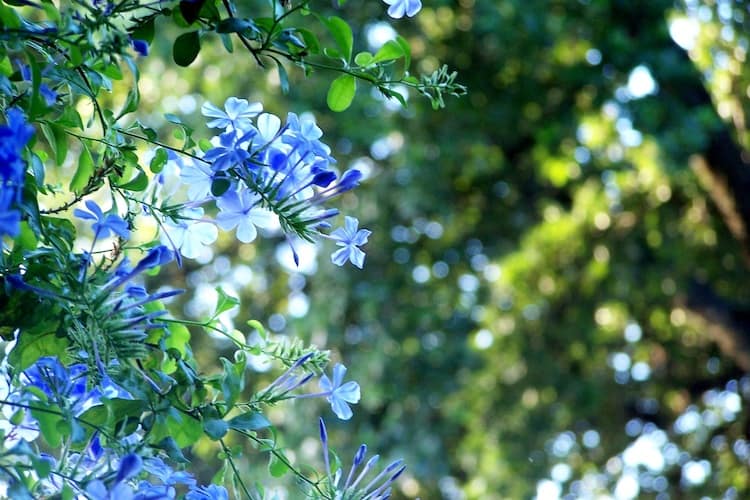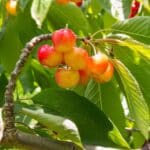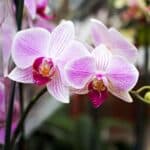If you are looking for a gorgeous plant that is easy to care for, can survive long humid summers, and is drought tolerant, then look no further than blue plumbago plant.
Plumbago plant is an excellent plant for landscape design as a sprawling shrub with branches that look like vines. It also has few pests and diseases that trouble it, thus making it a favorite option for gardeners who like to think themselves as plant killers.
Despite the simplistic nature of the plumbago plant, it is still imperative that you know how to care for blue plumbago plant. This would ensure that you have an all year round of brilliant blast of blue in your landscape.
Table of Contents
Overview of Blue Plumbago Plant
Plumbago plant ‘Plumbago auriculata,’ also referred to as sky flower or the Cape plumbago, is a shrub that originates from South Africa grown mostly for decorative purposes.
Blue plumbago, when grown in a natural environment, can grow as tall as 6 – 10 feet and spread out as much as to 8 – 10 feet. Blue plumbago thrives in hot regions, and can tolerate drought, but dies off in very low temperature.
Blue plumbago should be taken inside a home for protection to avoid its death due to frost during cold winters. It has a few pests and diseases and is resistant to deer.
In regions of the United States such as Southern Texas and Florida, blue plumbago grows all year round. It serves a variety of purposes as it can be used as ground cover, as a container planter, like hedging, a climber on supports or trellis or cascading down from a hanging basket.
Blue Plumbago is also used to decorate the porch or patio throughout the months of autumn, springs, and late summer, because it produces an abundant cluster of attractive blue flowers.
Blue plumbago has a pleasant scent; hence it attracts various harmless birds and insects like butterflies to it. These birds and insects also improve the overall aesthetics of a landscape where blue plumbago is grown.
Uses of Blue Plumbago Plants

Blue plumbago serves a variety of purposes. It can be shaped to trail up and over structures like archways and trellises. Blue plumbago is also used to make a beautiful informal hedge, and can also be pruned to form a formal hedge.
Additionally, blue plumbago is used as a filler in mixed gardens, as a colorful addition to walls and surfaces and as a screening plant. Flowers of blue plumbago also attract a wide range of beneficial pollinators like butterflies, and it serves as a focal point for wildlife.
How to Plant Blue Plumbago
Blue plumbago is best grown in slightly acidic soils that drain properly and have a light texture. Planting blue plumbago in alkaline soils would result in the yellowing of the plant’s foliage.
However, if the soil is inherently alkaline, you can correct it to suit blue plumbago by adding manganese sulfate to it. Always heed to the manufacturer’s instruction for doses and application details.
If you are growing the blue plumbago in a pot, you should use a 3-gallon container and a rich potting mix that drains properly.
Blue plumbago needs full sunlight to flower appropriately and heavily. Therefore you should grow the plant in an area where it receives ample sunlight.
However, it tolerates partial sunlight and partial shade, but the flowers it would produce in such conditions would not be as full as those produced in conditions of full sunlight.
Depending on the current weather of the area where you are growing blue plumbago, it requires that you water it at least once or twice weekly.
You do this until the roots become established in the landscape. It usually takes about six weeks for blue plumbago to get established after planting.
Once the roots have been established, you can water the plant once or twice every week. But if your blue plumbago is grown in a pot, frequent watering is required. You also water the plant in a pot when an inch or two inches of the topsoil is dry to the touch.
Although blue plumbago is tolerant of drought, you shouldn’t starve it young.
Blue plumbago requires an all-purpose fertilizer applied twice a year to it to bloom. It is not a heavy feeder! Apply fertilizer to it by springtime and in summer while the plant is actively growing. Ensure to follow the manufacturer’s directions on application details and appropriate amount.
To avoid foliage burn, water the fertilizer into the soil after application and rinse off any fertilizer that may have fallen on the foliage.
For blue plumbago plants that are grown in containers, they would require an all-purpose, water-soluble fertilizer. As always, stick to the manufacturer’s guide for instructions.
Read Also: How to Grow Dwarf Banana Plant
How to Care For Blue Plumbago Plant

How to care for blue plumbago plant would be explained under the following subheadings;
Watering Blue Plumbago Plant
The position of your blue plumbago plant determines, to a great extent, how much watering it would require. If your blue plumbago is grown outside under direct sunlight, then it would require much water, and that means frequent watering.
But if it is grown in a shady place with cooler temperature, it would require less watering, and this means irregular watering of the plant.
However, blue plumbago plant enjoys adequate watering throughout spring and summer with those grown in containers requiring more watering attention than those grown directly in the ground.
Blue plumbagos grown in the ground have more options for their roots to search out moisture and get it than those grown in containers.
Blue plumbagos grown in containers do not have many options to source for moisture; hence they would require a regular watering schedule. The idea is to get the plant-soil moist and not dripping wet, so water with caution.
Adding an adequate amount of water to potted plumbago would help reduce the risk of it developing root rot, unlike those grown in the ground that has more depth for excess water to drain into.
Best Temperature for Blue Plumbago
Due to the fact that blue plumbago is native to South Africa, it thrives in warm climates. The ideal climate to grow and care for blue plumbago is hot to warm climate. It thrives in mild climates too.
The least temperature that plumbago can thrive in is the temperature of about 32 degrees F. If you live in areas where the temperature falls below this value. As a care tip, you would have to take your plumbago plant inside whenever the temperature falls so low.
Or you cut down the plant to the ground level and wait until spring for it to come back alive.
Best Humidity for Blue Plumbago
Blue plumbago enjoys high humidity and thrives in an environment with naturally moist air. Ensure to provide it with proper humidity, although it tolerates moderate humidity.
But the problem that comes with moderate humidity is that the plant may not bloom as it ought to.
Fertilizer
Blue plumbago plants derive benefits from any kind of fertilizer, including all-purpose fertilizers. However, fertilizers rich in potassium will help the plant produce more luscious flowers, while fertilizers rich in phosphorus will help the plant develop a good root system.
Overall, a good fertilizer would help improve the plant’s long term health and growth. Whichever type of fertilizer you choose, ensure to follow the manufacturer’s guide for amount and method of application.
To be sure about the fertilizer’s suitability for your plant, you can carry out in-depth research based on your budget and requirements from the fertilizer for your plant.
Pruning
The blue plumbago plant grows very first and would require constant check-up and maintenance to keep it under control. If not well pruned, blue plumbago can grow out of control to become as large as 10 feet wide and as tall as 10 feet.
There is no ideal manner of pruning blue plumbago because different people use it for various purposes. While plumbago is regarded as a shrub, it climbs.
You can prune blue plumbago to form a hedge or to encourage new growth. When grown edges of the plant are pruned, new flowers appear.
If you are using the plant as a landscape cover, you can prune it from encroaching into other plants or areas you don’t want it covering.
When used as a cascading plant hanging from a basket, blue plumbago would require a lot of pruning. If not properly pruned, the plant would appear messy, and the entire decorative purpose would be defeated.
If you are growing it in a container and prune it heavily, the plant will form a shrub. Then you can prune it into any shape you like and enjoy the pleasant aesthetics it offers.
At the start of spring, you can prune the plant down to the root and allow it to bloom back to life again. But at the beginning of winter, you may wish to bring in the potted plumbago plant to protect it from dying off as a result of low temperature.
Before taking it into your house, you need to prune it down to a moderate size. While inside your home, position it in a warm, bright position so that it can still bloom and thrive.
Repotting
This care tip is for those that grow their blue plumbagos in containers. Potted blue plumbagos are expected to re-potted every 2 to 3 years to enable the plant to remain healthy and continue growing.
Blue plumbago plants grow at a very rapid rate and can quickly fill up pot spaces. To ensure that its growth is not stunted, you should re-pot it at least every two years.
The ideal time to re-pot blue plumbago plants is either at the beginning of spring or early summer.
You can re-pot at the beginning of spring when you are ready to move the plant outside after being indoors against cold. At this time, the plant should be pruned to a manageable size that would enable you to re-pot it.
You can also re-pot in early autumn when you want to bring in the plant for winter. At this time, too, the plant is pruned and can be easily re-potted.
To re-pot the plant, remove it gently from the pot and use your fingers to remove soil from the root. Break off as much old soil from the plant root as possible. Re-plant the plumbago in a new pot that is twice the size of the former pot.
Replace the loosened soil with a new rich soil mix. Start taking care of it as you would do for a new plant. When the roots have established, you can continue the routine care for it.
Conclusion
How to care for a blue plumbago plant is quite easy, as the plant is resistant to a lot of harmful organisms and thrives in hot weather.
However, you can improve its optimal growth and development by always ensuring to wipe the blades of any pruning tool used before and after each use. This would discourage disease transfer between plants. You can clean the tool with a clean cloth soaked with alcohol.
If you wish to grow several blue plumbagos, give each plant about 36 inches space from other plants to enable each of them to breathe well and spread out beautifully.
Blue plumbago should be grown outdoors due to its size and pattern of growth. It is not ideal for indoors.
Read Also:





Leave a Reply